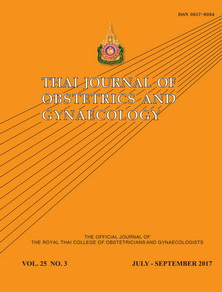The Difference of Creamatocrit in Colostrum between Preterm and Term Delivery Women
Main Article Content
Abstract
Objectives: To demonstrate the difference of fat concentration in colostrum between mothers with preterm delivery and mothers with term delivery, using creamatocrit (CRCT) as an analytic method.
Materials and Methods: The enrollment period was from January to June, 2016. Two hundred and twenty nursing mothers were divided into 2 groups based on gestational age, 44 preterm and 176 term delivery mothers in the first and second groups, respectively. Colostrum was collected from all participants on the third day postpartum before transferred into capillary tubes and sorted into groups to perform CRCT. CRCT were compared between groups using univariable and multivariable regression analysis to clarify indicators that effected CRCT.
Results: The demographic data were no different in terms of age, blood pressure, body mass index, body weight, height, parity and types of delivery. As from CRCT analysis, mean value of CRCT from colostrum in samples from preterm and term groups were 5.89±2.20% and 6.59±2.50%, (p > 0.05). Secondary analysis of age, maternal total weight gain, body mass index at delivery, hypertension, diabetes, parity, route of delivery, hematocrit at delivery and newborn birth weight were no difference.
Conclusion: By using CRCT analysis, the outcome of fat concentration for both delivery groups showed no differenceand no effect from age, body weight, total weight gain during gestation, parity, maternal blood pressure and types of delivery.
Article Details
References
2. Thoene M, Hanson C, Lyden E, Dugick L, Ruybal L, Anderson-Berry A. Comparison of the effect of two human milk fortifiers on clinical outcomes in premature infants. Nutrients 2014;6:261–75.
3. Moltó-Puigmartí C, Castellote AI, Carbonell-Estrany X, López-Sabater MC. Differences in fat content and fatty acid proportions among colostrum, transitional, and mature milk from women delivering very preterm, preterm, and term infants. Clin Nutr 2011;30:116–23.
4. Lucas A, Gibbs JA, Lyster RL, Baum JD. Creamatocrit: simple clinical technique for estimating fat concentration and energy value of human milk. Br Med J 1978;1(6119) :1018–20.
5. O’Neill EF, Radmacher PG, Sparks B, Adamkin DH. Creamatocrit analysis of human milk overestimates fat analyzer using mid-infrared spectroscopy. JPGN 2013;56:569–72.
6. Lin HY, Hsieh HY, Chen HH, Chiu HY, Lin HC, Su BH. Efficacy of creamatocrit technique in evaluation of premature infants fed with breast milk. Pediatr Neonatol 2011;52:130–4.
7. Vieira AA, Moreira ME, Rocha AD, Pimenta HP, Lucena SL. Assessment of the energy content of human milk administered to very low birth weight infants. J Pediatr (Rio J) 2004;80:490–4.
8. Callen J, Pinelli J. A review of the literature examining the benefits and challenges, incidence and duration, and barriers to breastfeeding in preterm infants. Adv Neonatal Care 2005;5:72–88.
9. Liu P, Qiao L, Xu F, Zhang M, Wang Y, Binns CW. Factors associated with breastfeeding duration : a 30-month cohort study in Northwest China. J Hum Lact 2013;29:253–9.
10. Kociszewska-Najman B, Borek-Dzieciol B, Szpotanska-Sikorska M, Wilkos E, Pietrzak B, Wielgos M. The creamatocrit, fat and energy concentration in human milk produced by mothers of preterm and term infants. J Matern Neonatal Med 2012;25: 1599–602.
11. Meier PP, Engstrom JL, Zuleger JL, Motykowski JE, Vasan U, Meier WA, et al. Accuracy of a user-friendly centrifuge for measuring creamatocrits on mothers’ milk in the clinical setting. Breastfeed Med 2006;1:79–87.
12. Kleinman RE . Pediatric Nutrition Handbook. 6 th ed. Illinois : American Academic of Pediatrics, 2009. 1470 p.
13. Uauy R, Castillo C. Lipid requirements of infants: implications for nutrient composition of fortified complementary foods. J Nutr 2003;2962S–72S.
14. Cristofalo EA, Schanler RJ, Blanco CL, Sullivan S, Trawoeger R, Kiechl-Kohlendorfer U, et al. Randomized trial of exclusive human milk versus preterm formula diets in extremely premature infants. J Pediatr 2013;163:1592–5.
15. Embleton NE, Pang N, Cooke RJ. Postnatal malnutrition and growth retardation: an inevitable consequence of current recommendations in preterm infants?. Pediatrics 2001;107:270–3.
16. Ganapathy V, Hay JW, Kim JH. Costs of necrotizing enterocolitis and cost-effectiveness of exclusively human milk-based products in feeding extremely premature infants. Breastfeed Med 2012;7:29–37.
17. Kramer MS, Chalmers B, Hodnett ED, Sevkovskaya Z, Dzikovich I, Shapiro S, et al. Promotion of Breastfeeding Intervention Trial (PROBIT): a randomized trial in the Republic of Belarus. JAMA 2014;285:413–20.
18. Dewey KG, Heinig MJ, Nommsen LA. Maternal weight-loss patterns during prolonged lactation. Am J Clin Nutr 1993;58:162–6.
19. Kronborg H, Harder I, Hall EO. First time mothers’ experiences of breastfeeding their newborn. Sex Reprod Healthc 2015;6:82–7.
20. Lovelady CA, Garner KE, Moreno KL, Wiliiums JP. The effect of weight loss in overweight, lactating women on the growth of their infants. N Engl J Med 2000; 342:449–53.
21. Paton LM, Alexander JL, Nowson CA, Margerison C, Frame MG, Kaymakci B, et al. Pregnancy and lactation have no long-term deleterious effect on measures of bone mineral in healthy women: A twin study. Am J Clin Nutr 2003;77:707–14.
22. Martin RM, Patel R, Kramer MS, Vilchuck K, Bogdanovich N, Sergeichick N, et al. Effects of promoting longer-term and exclusive breastfeeding on cardiometabolic risk factors at age 11.5 years: A cluster-randomized, controlled trial. Circulation 2014;129 :321–9.
23. Bartick MC, Stuebe AM, Schwarz EB, Luongo C, Reinhold AG, Foster EM. Cost analysis of maternal disease associated with suboptimal breastfeeding. Obstet Gynecol 2013;122:111–9.


